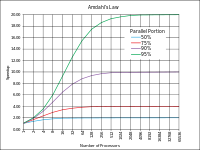- Task parallelism
-
Task parallelism (also known as function parallelism and control parallelism) is a form of parallelization of computer code across multiple processors in parallel computing environments. Task parallelism focuses on distributing execution processes (threads) across different parallel computing nodes. It contrasts to data parallelism as another form of parallelism.
Contents
Description
In a multiprocessor system, task parallelism is achieved when each processor executes a different thread (or process) on the same or different data. The threads may execute the same or different code. In the general case, different execution threads communicate with one another as they work. Communication takes place usually to pass data from one thread to the next as part of a workflow.
As a simple example, if we are running code on a 2-processor system (CPUs "a" & "b") in a parallel environment and we wish to do tasks "A" and "B" , it is possible to tell CPU "a" to do task "A" and CPU "b" to do task 'B" simultaneously, thereby reducing the run time of the execution. The tasks can be assigned using conditional statements as described below.
Task parallelism emphasizes the distributed (parallelized) nature of the processing (i.e. threads), as opposed to the data (data parallelism). Most real programs fall somewhere on a continuum between Task parallelism and Data parallelism.
Example
The pseudocode below illustrates task parallelism:
program: ... if CPU="a" then do task "A" else if CPU="b" then do task "B" end if ... end program
The goal of the program is to do some net total task ("A+B"). If we write the code as above and launch it on a 2-processor system, then the runtime environment will execute it as follows.
- In an SPMD system, both CPUs will execute the code.
- In a parallel environment, both will have access to the same data.
- The "if" clause differentiates between the CPU's. CPU "a" will read true on the "if" and CPU "b" will read true on the "else if", thus having their own task.
- Now, both CPU's execute separate code blocks simultaneously, performing different tasks simultaneously.
Code executed by CPU "a":
program: ... do task "A" ... end program
Code executed by CPU "b":
program: ... do task "B" ... end program
This concept can now be generalized to any number of processors.
JVM Example
Similar to the previous example, Task Parallelism is also possible using the Java Virtual Machine JVM.
The code below illustrates task parallelism on the JVM using the commercial third-party Ateji PX extension[1]. Statements or blocks of statements can be composed in parallel using the || operator inside a parallel block, introduced with square brackets:
[ || a++; || b++; ]
or in short form:
[ a++; || b++; ]
Each parallel statement within the composition is called a branch. We purposely avoid using the terms task or process which mean very different things in different contexts.
Languages
Examples of (fine-grained) task-parallel languages can be found in the realm of Hardware Description Languages like Verilog and VHDL, which can also be considered as representing a "code static" software paradigm where the program has a static structure and the data is changing - as against a "data static" model where the data is not changing (or changing slowly) and the processing (applied methods) change (e.g. database search).[clarification needed]
See also
- Data parallelism
- Algorithmic skeleton
Notes
- ^ http://www.ateji.com/px/patterns.html#task Task Parallelism using Ateji PX, an extension of Java
References
- Quinn Michael J, Parallel Programming in C with MPI and OpenMP McGraw-Hill Inc. 2004. ISBN 0-07-058201-7
- D. Kevin Cameron coined terms "data static" and "code static".
Parallel computing General 
Levels Threads Theory Elements Coordination Multiprocessing · Multithreading (computer architecture) · Memory coherency · Cache coherency · Cache invalidation · Barrier · Synchronization · Application checkpointingProgramming Hardware Multiprocessor (Symmetric · Asymmetric) · Memory (NUMA · COMA · distributed · shared · distributed shared) · SMT
MPP · Superscalar · Vector processor · Supercomputer · BeowulfAPIs Ateji PX · POSIX Threads · OpenMP · OpenHMPP · PVM · MPI · UPC · Intel Threading Building Blocks · Boost.Thread · Global Arrays · Charm++ · Cilk · Co-array Fortran · OpenCL · CUDA · Dryad · DryadLINQProblems Embarrassingly parallel · Grand Challenge · Software lockout · Scalability · Race conditions · Deadlock · Livelock · Deterministic algorithm · Parallel slowdown
Categories:
Wikimedia Foundation. 2010.
